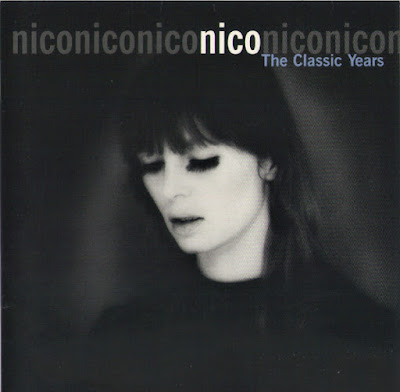Christa Päffgen (16 October 1938 – 18 July 1988), known by her stage name Nico, was a German singer, songwriter, actress and model.
Nico was born Christa Päffgen in Cologne to Wilhelm and Margarete "Grete" Päffgen. When Nico was two years old, she moved with her mother and grandfather to the Spreewald forest outside Berlin to escape the World War II bombardments of Cologne. In 1946, Nico and her mother relocated to downtown Berlin, where Grete worked as a seamstress. She attended school until the age of 13, and began selling lingerie in the exclusive department store KaDeWe, eventually getting modelling jobs in Berlin. At 5 ft 10 in (178 cm), and with chiseled features and pale skin, Nico rose to prominence as a fashion model when still a teenager.
Nico was discovered at 16 by photographer Herbert Tobias while both were working at a KaDeWe fashion show in Berlin. He gave her the name "Nico" after a man he had fallen in love with, filmmaker Nikos Papatakis, and she used it for the rest of her life. She moved to Paris and began working for Vogue, Tempo, Vie Nuove, Mascotte Spettacolo, Camera, Elle, and other fashion magazines. Around this time, she dyed her brown hair blonde, later claiming she was inspired to do so by Ernest Hemingway. At age 17, she was contracted by Coco Chanel to promote their products, but she fled to New York City and abandoned the job. Through her travels, she learned to speak English, Spanish, and French.
Nico studied acting at Lee Strasberg's New York Actor Studio and in 1959, she was invited to the set of Federico Fellini's La Dolce Vita, where she attracted the attention of the acclaimed director, who gave her a minor role in the film as herself. After a role in the 1961 Jean Paul Belmondo film A Man Named Rocca, she appeared as the cover model on jazz pianist Bill Evans' 1962 album, Moon Beams. After splitting her time between New York and Paris, she got the lead role in Jacques Poitrenaud's Strip-Tease (1963).
In New York, Nico first met Greek filmmaker Nico Papatakis, whose name she had adopted as her stage name several years earlier. The two lived together between 1959 and 1961. After noticing her singing around the apartment, Papatakis asked her if she had ever considered a career in music and ended up enrolling her in her first singing lessons.
She then became part of the Swinging London scene, and had a short relationship with The Rolling Stones' Brian Jones and she recorded her first record in London in 1965, the single I'm Not Saying/The Last Mile, produced by Jimmy Page, for Rolling Stones manager Andrew Loog Oldham's label Immediate Records.
Thanks to Jones she met Andy Warhol in New York City and became part of Warhol's Factory, and Warhol introduced her to the Rock band The Velvet Underground, with whom she recorded the album "The Velvet Underground & Nico", featuring the legendary banana cover designed by Andy Warhol. The album has been named by numerous publications as one of the top 100 albums of all time, and is often considered one of history's 10 most influential albums by critics.
In 1967 she met and began a relationship with The Doors’ frontman Jim Morrison. Although their time together was tempestuous, it emboldened Nico to see herself as a creative artist in her own right. At Morrison’s encouragement she bought a harmonium so that she could write music and, importantly, accompany herself when she performed, so she was no longer shackled to backing guitarists.
Nico later recorded several solo albums, including the folksy Chelsea Girl in 1967, followed by original albums such as The Marble Index and Desertshore, which were much darker and avant garde in style. She released several more albums throughout the 1970s. In 1981, Nico played a show in Manchester and afterwards confessed to promoter Alan Wise that she had nowhere to go. He gave her a place to stay, beginning a seven-year period in which she lived predominantly in the city. While she was by now living with a serious heroin addiction, Wise’s stewardship helped her return to touring and recording. In 1985 Nico recorded “Camera Obscura,” her first album in 11 years and released in the United States on the PVC label. Despite what critics found a pleasant mix of new material and such evergreen songs as “My Funny Valentine,” it failed to attract much popular attention.
In her final years she performed her tragic repertoire less frequently and gradually came to spend most of her time in Ibiza where she died on 17 July 1988 from a cerebral hemorrhage after falling from her bike. She was only 49 years old. She is buried in Berlin, next to her mother.
(Edited from Wikipedia, Independent & IMDb)








